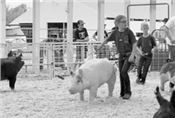|
Roots Of Resilience Run Deep In 4-H And Agriculture: A Reflection

Earl and Marjorie Rogers next to Marjorie’s father’s truck, which came with them from Colorado.
Photo credit: Shirley Peckman.
COLUMBIA, MO.
Resilience. The agriculture industry is all too familiar with this word. When I stop and think about what resilience means to me, I am taken back to my childhood when my grandparents would share stories of what it was like for them growing up during the Dust Bowl in the 1930s. I found it unimaginable when my grandpa shared how they had to tie ropes from the house to the barns so that they could find their way to do chores. It was unfathomable when grandma told how she and her sisters had to wipe the dust and grime from their plates before eating. During those days it was common to wear some form of face covering to keep from breathing in dust.
The astonishing stories my grandparents shared were for them what we today would call the “new normal.” Youths involved in agriculture across Missouri and the United States are in the midst of their own, less dusty, challenge.
4-H is a youth-based organization with a mission of “engaging youth as valued, contributing members of their communities in partnership with caring adults.” (1) 4-H engages youths through hands-on projects that help to develop knowledge and skills in range of content areas, including STEM, healthy living and civic engagement. After working hard to grow their skills and knowledge in a project area, 4-H members can showcase their efforts at county fairs. County fairs have a strong tradition in agriculture as an event where youths and producers come together to showcase their livestock and other agricultural products. Youths with an interest in agriculture may spend October through May – the months leading up the fair – raising a market steer, curing a ham or designing and fabricating a flatbed trailer.
Just as certain aspects of agriculture have changed over the years, many county fairs have adapted to include opportunities for youths to showcase more contemporary as well as traditional agriculture exhibits. Regardless of the exhibit, county fairs offer a positive environment where youths and adults come together for friendly competition and to exhibit the fruits of their labors.
Sadly, this year these traditional showcase events for agriculture and youths have faced a threat that we cannot see or touch. COVID-19 has created a new “normal” for how we experience the world around us. Many county fairs were canceled to protect exhibitors and attendees while reducing the financial burden on already strained local businesses that have long and generously supported these events and youths. However, as has been the case time and again, the resilience of agriculture offers solutions to meet today’s unique challenge. Through great efforts and time invested in planning, some counties have created modified county fairs for their youths.
When asked about her project experience during COVID-19, Monroe County 4-H member Morgan Crain said, “It was kind of hard because at first we didn’t know what was to come in the end, or if we would have a show season.”
Examples of county fair modifications can be found in rural and urban settings alike as those involved worked toward a shared goal of providing a quality experience for their youths. The recently renovated fairgrounds in southwestern Dade County will be a lot quieter this year due to COVID-19, according to Bob McNary, county engagement specialist in 4-H youth development for MU Extension in Dade County. “We transitioned to a modified live and virtual county fair this year, where we held the livestock shows virtually and had a smaller in-person event for showmanship,” McNary said.
To the north, in urban Clay County, the Clay County 4-H Fair transformed into an almost completely virtual event, with participants submitting photos and videos of projects and demonstrations for judging. “Overall, we had a good turnout and received lots of positive feedback,” said Sarah Morefield, 4-H youth development specialist for MU Extension in Clay County. “We received thank-you’s from 4-H parents and club leaders for giving them a sense of normalcy during this time.” Her members seemed to flourish despite these less than ideal circumstances. “Easily one of my favorite moments was seeing two 4-H’ers realize they were in the same Zoom room in line for judging,” she said. “And in the excitement, they had to unmute and chat about what they were doing, their projects and how judging was going.”
I have come to realize there is something that runs deeper than knowledge and skills in agriculture. That “thing” is resilience. New production methods and land management practices born from the resilience shown by American agriculture at the end of the 1930s helped guide the United States back to prosperity in the 1940s, and it helped avoid a repeat Dust Bowl in the 1950s. (2) This resilience has grown strong roots for today’s youth in agriculture, as well as for the generations to come.
As they work through the challenges of COVID-19 throughout the 2020 county fair season, youths and adults across Missouri have shown resilience. “It definitely shows you that doing this project keeps your hopes up and how important our show family is to help us get through this rough situation,” Monroe County 4-H’er Crain said.
Challenges will come and go, but strong roots keep us standing. ∆

Young 4-H member exhibiting market hog at a county fair.
Photo credit: Monica Linn.
|
|